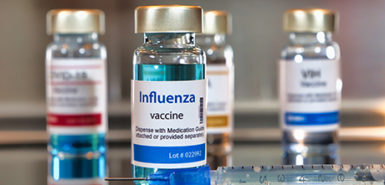
Even the friendliest of our furry friends can have an off day.
The statistics bear it out: Approximately 4.5 million dog bites happen each year in the U.S., according to the Centers for Disease Control and Prevention.
And many of these incidents could be avoidable.
Paying attention to a dog’s cues—and asking the owner before you pet a dog—can lessen the chances of a bite, said Spectrum Health police Sgt. Cooper “Coop” Watkins, a certified trainer for dual purpose police dogs who trains and oversees the team of eight police dogs at Corewell Health West Michigan.
“The golden rule is to ask before you approach,” Watkins said.
An owner knows their dog best, and they should let you know if it’s a good time to interact, Watkins said.
You should be aware of certain behaviors or actions when approaching a dog for the first time.
“The dog may be telling you they don’t want to be petted right now,” Watkins said. “So, paying attention to body language cues can be extremely helpful.”
Ask before petting
Always ask for permission before approaching or petting a dog, Watkins said.
“In our field of working with professional working dogs, I can tell when one is not having a good day,” he said. “And I can tell when he may not want to be pet. You should always ask first.”
You never know if a dog might have an injury, or if it’s not social.
“Not every dog is friendly,” he said. “They may appear so from a distance, but once you get inside their bubble, everything can change.”
Dogs have personal space just like humans, he said. You don’t want to enter that space if the dog is not ready. The animal could misinterpret a person’s approach and consider it a threat.
“Once you corner a dog, the last resort will be for the animal to try and get out of the situation,” he said. “And dogs always use their mouth to show when something is not right.”
To help avoid a bite incident, don’t allow for unsupervised interactions with new dogs.
Warning signs
“I would say always proceed with caution,” Watkins said. “Dogs will give you signs of apprehension or approval, so it’s always good to be aware.”
You want the dog to approach you first, he said. Even if the owner gives you permission to pet the dog, that doesn’t necessarily mean the interaction will go well.
If a dog doesn’t want to be touched, it may back away, lean into its owner, lay its ears back, bark, growl, tremble or show teeth.
“They can’t speak to us in a language we understand, so we need to use our eyes to interpret what they are trying to tell us,” Watkins said. “If the dog is showing you that he is not OK with this, take a moment, take a step back and let the dog come to you.”
Best ways to approach
Stand in a non-aggressive manner and let the dog come into your space. Don’t push the interaction.
“It’s not always safe to put your hand out,” Watkins said. “Some dogs can see this as a challenge.”
Don’t position yourself over the dog’s body, as the animal may view this as a sign of dominance.
“Don’t do anything that can be seen as a challenge or dominance,” Watkins said. “Treats can be good introduction, too, if the owner allows and is a part of the interaction—but it’s different from dog to dog.”
As a dog owner, there are a few things you can do to prepare your dog for a new interaction.
“I always make my dog sit first. I give them a command to make them know it’s OK to be pet first,” he said. “There are things you can do as a handler to make it easier on people by creating a routine or ritual that needs to be completed before someone can pet them.”
Watch for aggressive dogs
The biggest thing to remember is to remain calm. Don’t yell or do anything that makes you appear aggressive.
“Dogs read body language on us just like we do with them,” Watkins said. “If you stare at them in the eye, yell or engage, they could see it as a challenge.”
Make slow movements and back away from the dog.
“Get out of the dog’s space and walk away,” Watkins said. “Move slow and don’t be the rabbit.”
Watkins said dogs have a natural drive to pursue their prey. If you run, the dog will naturally want to pursue you. It’s a challenge or a game, based on instinct.
If your dog is attacked
If your dog has an encounter with another dog, don’t jump into the fray.
“There will be a lot of noise and biting if your dog is involved and, if you get in there, you are going to get bit,” Watkins said.
You can try to distract the dogs with water, if it’s available. Or, if the other dog’s owner is present, you can both try to pull the dogs away from each other by the hind legs—but Watkins warned about doing this alone.
“Avoid the hot zones, including the neck, face and mouth,” he said. “And do not stand over or tower over the dogs, as this could be seen as an act of dominance.”
How to handle a dog bite
If you are attacked by a dog, cover your face, neck and vital organs. Call for help or try to remove yourself from the situation.
“There are aggressive dogs, just like there are aggressive people out there,” Watkins said. “But most dogs aren’t looking for a fight. It happens mostly out of chance.”
Awareness of your surroundings can prevent most altercations, Watkins said.
“I have seen so many dog bites happen from someone stumbling into a dog’s space, into his yard or domain, and catching him off guard,” he said. “Watch for stray dogs when you are out for a walk. Keep your eyes open and be aware.”
Often, a dog bite will happen so quickly you can’t do anything to prevent it.
“Every circumstance is different,” he said. “It can happen with a family friend or neighbor, just as easily as it can with a stranger.”
If there is an incident, exchange contact information and ask about the dog’s vaccine history. Dog bites have a high infection risk, so clean the wound and seek necessary medical attention as appropriate.
 /a>
/a>
 /a>
/a>
 /a>
/a>
very informative